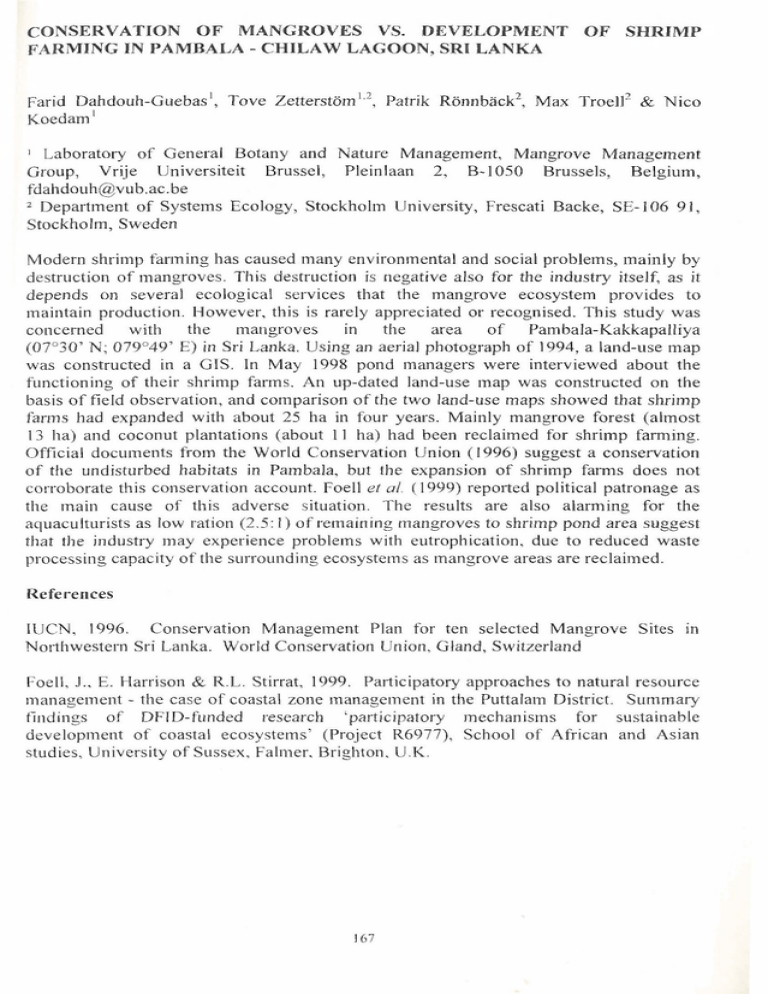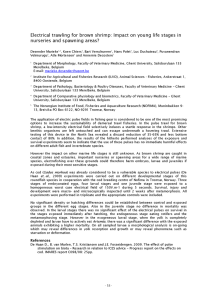CONSERVATION OF MANGROVES VS. DEVELOPMENT ... FARMING IN PAMBALA - CHILAW LAGOON, ...
advertisement

CONSERVATION OF MANGROVES VS. DEVELOPMENT FARMING IN PAMBALA - CHILAW LAGOON, SRI LANKA OF SHRIMP Farid D ahdouh-G uebas1, Tove Z etterstöm 1'2, Patrik R önnbäck2, M ax Troel]2 & N ico K oedam 1 1 Laboratory o f G eneral Botany and N ature M anagem ent, M angrove M anagem ent Group, V rije U niversiteit Brussel, Pleinlaan 2, B-1050 Brussels, B elgium , fdahdouh@ vub.ac.be 2 D epartm ent o f System s Ecology, Stockholm U niversity, Frescati Backe, S E -106 91, Stockholm , Sweden M odern shrim p farm ing has caused m any environm ental and social problem s, m ainly by destruction o f m angroves. This destruction is negative also for the industry itself, as it depends on several ecological services that the m angrove ecosystem provides to m aintain production. H ow ever, this is rarely appreciated or recognised. This study was concerned with the m angroves in the area of Pam bala-K akkapalliya (0 7 °3 0 ’ N; 079 °4 9 ’ E) in Sri Lanka. Using an aerial photograph o f 1994, a land-use map was constructed in a GIS. In M ay 1998 pond m anagers w ere interview ed about the functioning o f their shrim p farms. An up-dated land-use map was constructed on the basis o f field observation, and com parison o f the two land-use m aps show ed that shrim p farm s had expanded with about 25 ha in four years. M ainly m angrove forest (alm ost 13 lia) and coconut plantations (about 11 ha) had been reclaim ed for shrim p farm ing. O fficial docum ents from the W orld Conservation Union (1996) suggest a conservation o f the undisturbed habitats in Pambala, but the expansion o f shrim p farms does not corroborate this conservation account. Foell et al. (1999) reported political patronage as the main cause o f this adverse situation. The results are also alarm ing for the aquaculturists as low ration (2.5:1) o f rem aining m angroves to shrim p pond area suggest that the industry m ay experience problem s with eutrophication, due to reduced w aste processing capacity o f the surrounding ecosystem s as m angrove areas are reclaim ed. References 1UCN, 1996. C onservation M anagem ent Plan for ten selected M angrove Sites in N orthw estern Sri Lanka. W orld C onservation Union, Gland, Switzerland Foell, J., E. H arrison & R.L. Stirrat, 1999. Participatory approaches to natural resource m anagem ent - the case o f coastal zone m anagem ent in the Puttalam District. Sum m ary findings o f D FID -funded research ‘participatory m echanism s for sustainable developm ent o f coastal ecosystem s’ (Project R6977), School o f A frican and Asian studies, U niversity o f Sussex, Falmer, Brighton, U.K. 167


